General Background
Roses belong to the Rosa family or genus. Rosa is the Latin word for rose. Roses are woody perennial plants, some of which are deciduous and some evergreen. There are over 300 species of rose and many thousands of cultivars, some have recorded that there are more than 30,000. A cultivar is a plant that has been grown from selective breeding programmes. It is hard to believe, but fossilised remains found in Colorado have proved that roses grew in the wild over 35 million years ago when primates started to evolve on the Earth. Roses have been delighting civilisations for thousands of years. They are some of the oldest plants known to be cultivated by mankind.
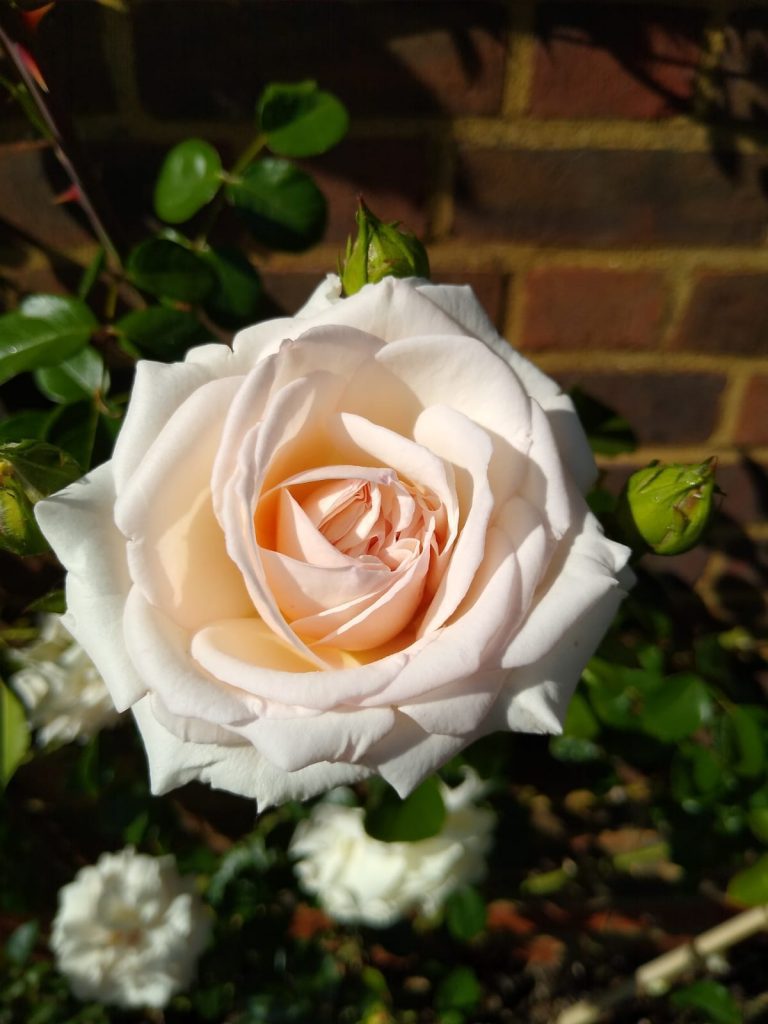
There are numerous flower shapes within the rose family which, together with the diversity of rose leaves and variety of prickles, display a wide range of growing habits which is unrivalled by any other plant family on Earth. Roses started life as wild roses, or Species roses, in the Northern Hemisphere. These wild roses were subsequently cultivated by man across the world. They have been cultivated in Europe, North America, Asia and Africa and have global affection and significance. Many countries attach symbolism and meaning to these beautiful flowers. Roses now grow in a wide variety of forms including the wild roses, shrub roses, rambling roses, trailing roses, hybrid tea roses, Floribunda roses, standard roses, ground cover roses and climbers (climing roses s can be seen in the picture to the right).. There are rose societies across the world including in Denmark, Australia, Germany, Japan, New Zealand and Mexico. There is a World Federation of Rose Societies which includes national societies from 41 different countries.
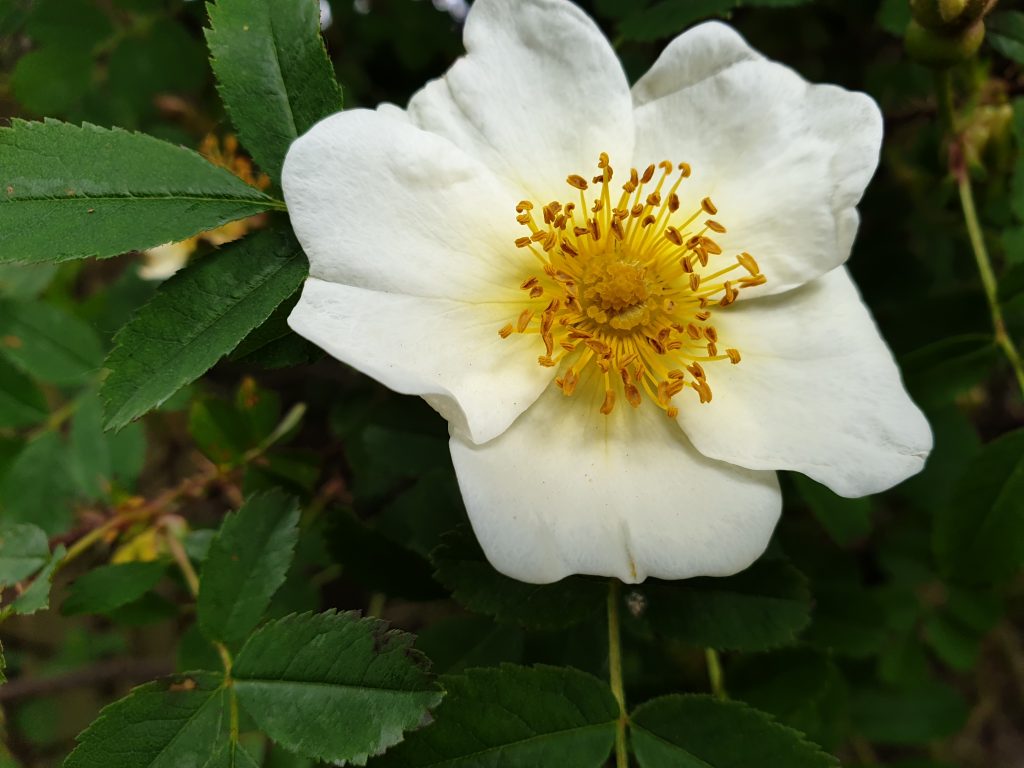
Wild roses today include Sweetbriars, Dog roses, Cinnamon roses and Rugosas, which are also known as Beach roses as they grow wild in Eastern regions of Asia on sand dunes and along the beaches. The wild or Species roses possess great charm because of the aromatic fragrances of their flowers, bark and leaves, the differences in their flower formations and their beautiful ornamental rose hips, which are the bright orange/red, dark red, purple or black berry-like fruits of the rose. The garden cultivation of roses from wild or Species roses probably started in China around 5000 years ago, but the Phoenicians, Greeks, Romans and the Crusaders in the Middle Ages were all instrumental in developing and introducing different varieties across Europe. By the 18th century there was a large variety of Old Shrub roses, which were hybrids from the wild or Species rose varieties. Old Shrub roses include Albas, Gallicas and Damask roses, which all display a perfect balance of foliage and showy flowers. Western cultivation of Shrub roses was developed from these times into the 19th century as more Chinese varieties were introduced and began to be crossed with Old Shrub varieties. From these developments, the modern Shrub roses, Climbers, Bush roses, Hybrid Tea roses, Floribundas, Miniature roses, Patio roses and Standard roses were developed.
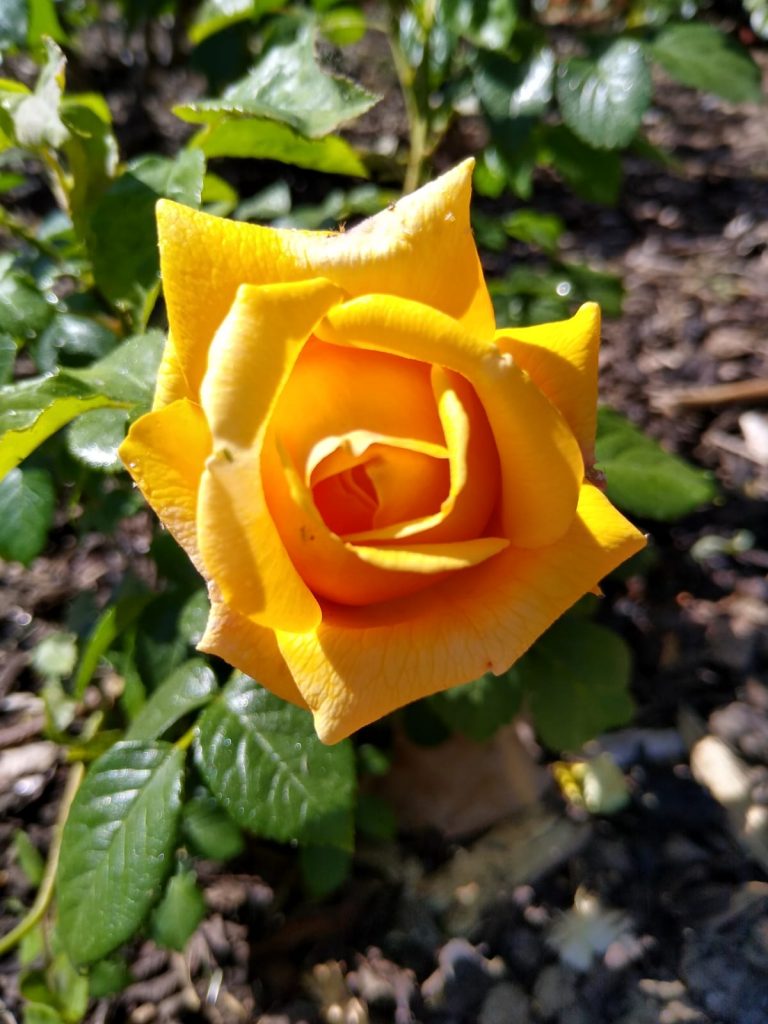
Propagation from cuttings grafting and seeds
The usual way to propagate roses is by taking cuttings from a mature shrub. Cuttings are best taken from the sides and top of a rose bush whilst it is growing and flourishing in summertime. Cuttings should be taken from young flexible stems about 4 to 6 inches in length with about three or four leaf buds showing. Cuttings need to be taken above a leaf bud at a 45-degree angle using a sharp cutting implement such as a gardening knife or secateurs. Remove all buds, faded blooms and the leaves towards the bottom of the cutting. Also remove or cut some of the other top leaves in half on the cutting to both increase the rooting potential and strengthen growth at the top.
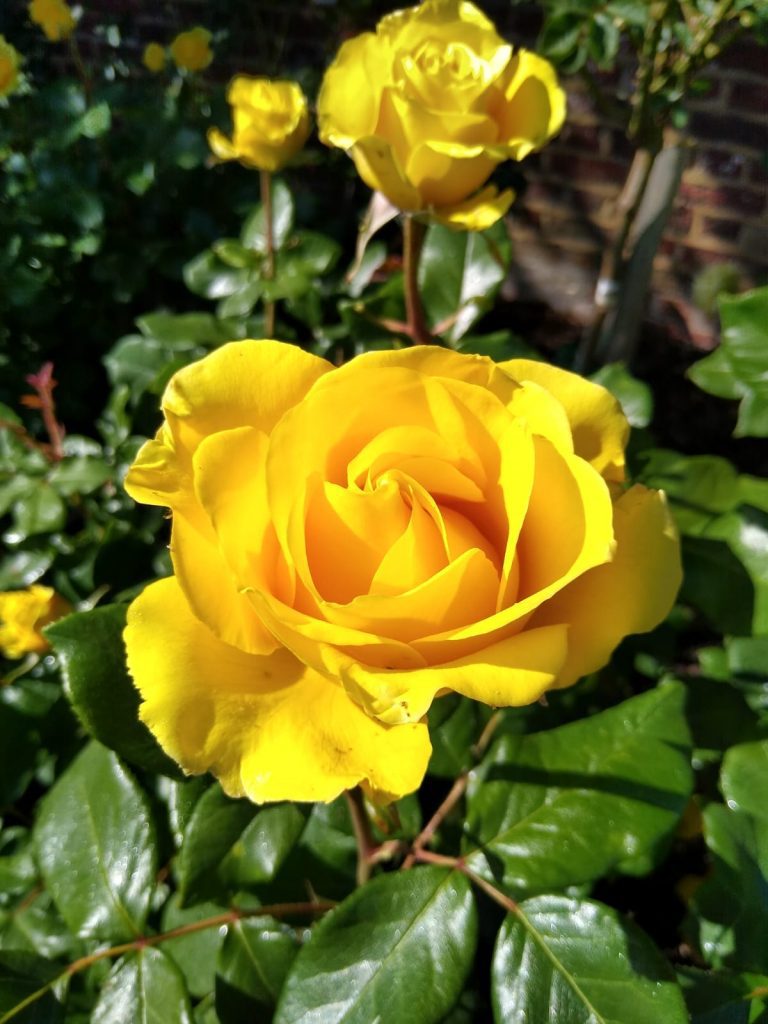
Roses tend to root readily and cuttings can be successfully started in a jam jar full of water. The more usual method of rooting is achieved by placing the cuttings in potting compost. Many growers tend to use commercially produced rooting powders for cuttings as there is a higher success rate using these. However honey can also be used as a natural alternative to rooting powder. Honey provides a sugar for the plants to feed on and thrive and also a moist culture for successful root growth. Dip the end of the cutting into honey, or if you decide to use rooting hormone dip the bottom 2 inches of the cutting into the rooting powder. Prepare a small plant pot by filling with a propagating mixture such as vermiculite, perlite or peat moss. These potting mixtures help to retain moisture without allowing the plant to become waterlogged. Make a hole in the compost with your finger or a pencil and place the prepared cutting into the hole and gently firm into place. Position the potted cutting in a greenhouse, or alternatively place a jam jar over the plant, or put the whole potted plant into a plastic bag in order to create a greenhouse effect which will encourage growth and increase moisture retention. Keep the potted cuttings in a warm but not overly hot place to root and the cuttings will be ready in about 8 – 10 weeks if the rooting has been successful. It is also fun to try to encourage the growth of different coloured flowers on a parent rose bush by attaching prepared cuttings from other bushes. This is called grafting. Prepare the cuttings using a rooting hormone powder or honey as described above. Make a V-shaped cut into the stem of the parent rose bush and insert the prepared cutting into the hole that has been made on the parent stem. Then take some tape or cloth to bind the cutting to the parent stem in order for the roots to develop within the parent’s stem. It is possible to grow pink, red, violet, white and yellow roses on a parent rose bush to get different coloured flowers on one bush. It’s not the easiest process, but it is really good fun to try to successfully graft different roses onto a parent plant. Many roses are bought as grafted roses. This is when a rose plant has not got the hardiest of root systems to maintain good stem growth. The graft is made on vigorous and hardy rose shrub roots, such as those of Species roses, which will sustain healthy stem, leaf and flower growth in the grafted rose. To plant roses from cuttings which have grown and developed strong root systems, the most important thing is to dig a hole which is deep and wide enough to allow the roots to spread and promote the optimal growing conditions. Fill the bottom of the prepared hole with organic compost such as horse manure⁰ or peat to encourage healthy growth. Place the plant in the prepared hole and fill it with the rest of the soil taken from the hole and firm into place. Water well and ensure that the rose is kept watered through the rest of the summer. Roses like to have moisture but never a waterlogged situation, so it is important to water carefully particularly in the early stages of new growth from a cutting. This new rose bush will produce beautiful flowers in the following year. It is also possible to grow roses from seeds. This is possible using varieties of Species roses which produce rose hips. Collect ripe rose hips in late Autumn and then, when ready for planting in or around November, remove the seeds. Rose hips that have dried out can be rehydrated in a cup of water to allow the seeds to be extracted. Use small pots filled with propagating mixture such as vermiculite. Moisten the mixture with sufficient water to create the potential for the mixture to hold together in a ball, but not for any excess water to be extracted when you squeeze the mixture. Scatter a few seeds on the mixture, lightly cover with more of the moistened mixture and cover the container with a lid. Small food storage pots, such as lidded Tupperware containers, are perfect for this job. Now place the small covered containers into a fridge to create a moist but cold environment to hold back the germination of seedlings until the springtime. This should take about 2 to 3 months and seedlings should be ready for transplanting in or around February which is the ideal time of year. The seedlings need to be about a quarter of an inch in length and have short white roots with white fibrous hairs. Place the seedlings gently in holes made with a pencil in seed boxes or individual pots, again using a propagating mixture such as vermiculite, perlite or peat moss. Keep the mixture moist in a greenhouse, or simulate a greenhouse effect by covering the containers with a plastic bag or placing or under a jam jar.
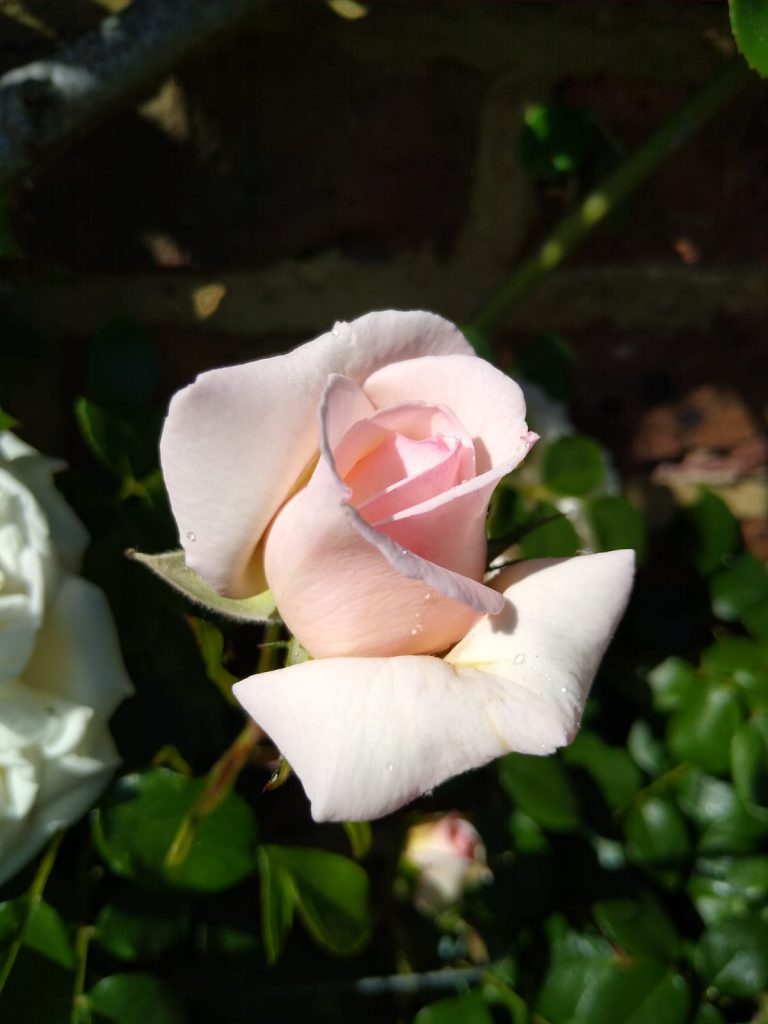
The seedlings will be ready to transplant into individual pots at the end of the year. These plants, grown from seeds, will be ready to be transplanted into a larger pot after a year’s growth and only ready to transplant out into the garden in Autumn or Spring after 2 years careful monitoring.
Planting Roses and General Care
There are so many choices of roses and a lot depends on what colour you want, what size of flower you want and where you want to grow the roses. Roses look great in any garden, whether against walls, if you prefer vigorous climbers or rambling roses, or as individually placed more compact plants such as a Hybrid Tea or Floribunda roses, or the miniaturised versions such as the patio plants which are container-sized roses. All provide wonderful colour in terms of their leaves and flowers throughout the summer, not forgetting the rose hips produced by certain varieties in winter Roses live for many long years if pruned, watered and cared for well. Roses prefer a well-drained rich loamy soil. They hate soil which is lime based or which has grown roses there before. If planting a rose in a place where other roses have been grown before it is important to replace the soil from the original bed with new soil. Roses appreciate extra helpings of horse manure or other organic fertilisers in springtime. Bonemeal is also another useful fertiliser when sprinkled liberally around the base of the plant and worked into the soil with a fork. Roses like to be kept watered throughout summer. Deadheading spent flowers encourages more flower production in one season. Roses which produce rose hips should not be deadheaded otherwise there would be no rose hips. Sometimes suckers appear on a rose plant and will need to be removed as they will drain the energy from the plant. Suckers are produced by the rootstock – that is the parent plant which has supported the grafting. They are identified as green upright vigorous shoots which appear at the base of the plant. Do not cut these, but twist and tear them off at the point where they shoot from the rootstock. Cutting suckers off can actually promote more vigorous growth and for this reason must be avoided at all costs. Some species of roses are hardier and less prone to disease than others. The most common diseases that affect roses are rust, black spot and mildew. Roses can also be affected by blackfly. All of these fungal diseases will need to be treated. Prevention must be considered as it is often better than the cure. For this type of fungus infection, you can either spray the plant with a good commercially produced fungicide, which can be obtained from any good garden centre, or alternatively you can make your own fungicide products at home. These would be cheaper, guaranteed to be organic and less harmful to other wildlife in the garden and yet doing the job of dealing with the problem effectively. To make your own fungicide, combine 1 or 2 teaspoons of baking powder (depending on the severity of the attack) in a pint of water. Add a teaspoon of cooking oil from the kitchen, which helps the solution stick to the leaves, and put a drop of eco-friendly washing up liquid to help emulsify the water and the oil. Mix until the baking soda has dissolved and pour into a pint sized spray bottle. These can be bought from any home and garden outlet costing about £1. They are not expensive. Before spraying, always give the bottle of homemade fungicide a quick shake to ensure that the ingredients are combined. Take care to spray the homemade fungicide, or other commercially produced fungicide products, onto the undersides of leaves as well as on the tops of leaves. This will ensure that the problem is eradicated and the plant will begin to improve and thrive through subsequent months. Many people spray fungicide through the dormant season in winter as a preventative measure. At the first sign of any of these problems in the growing season, use of a fungicide will help to stop the problem immediately.
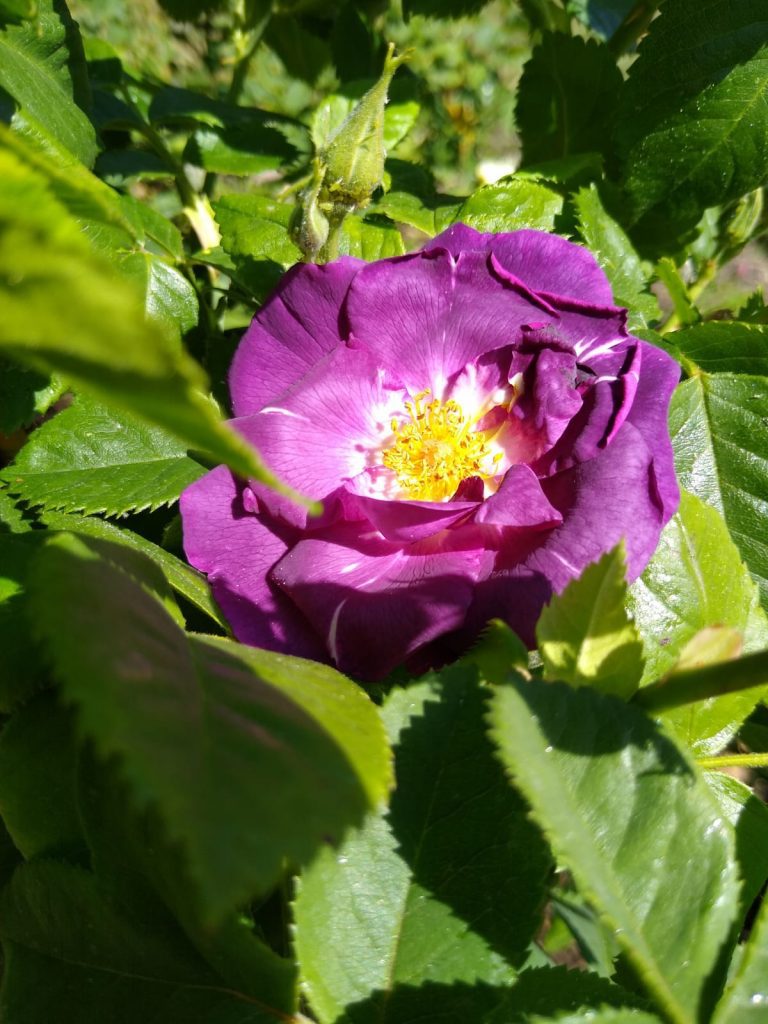
Pruning
Roses are pruned at the end of the flowering season in late summer or autumn, or alternatively at the beginning of spring in order to stimulate healthy new growth, to train the plant into a particular shape, or to maintain the shape of a plant.

Pruning removes any dead wood from the plant and shortens branches or stems that you wish to train or control. Always cut above a leaf bud angled at 45 degrees away from the bud and use sharp secateurs, or if the branch is thicker use a sharp pruning saw. To radically prune wilder bushes, a hedge trimmer or pruning shears can be used. Try to make sure that hand tools are kept clean and in good condition so that they make clean cuts on the rose bushes.
Significance and symbolism of roses
The ancient Greeks and Romans believed these flowers were associated with feelings of love of and affection. These flowers were linked with their respective goddesses of love, Aphrodite and Venus. Roses have been used to convey feelings of love and passion from these times. They can also convey different messages and are associated with confidentiality. For example a single rose signifies that one person loves another. 3 roses signify that the person is very much loved and is a traditional gift for a one month’s anniversary. 6 roses symbolise infatuation and the desire of one person to be another’s. 8 roses are a symbol of friendship and support and are given when a friend is going through a difficult time. 12 roses is the frequently gifted number of stems herself in a bouquet to say ‘be mine’ and ‘I love you’. 50 roses signify a boundless, infinite love which will last forever. The Romans and Greeks venerated these beautiful flowers and would decorate their homes with garlands of roses and also wear them around their necks. Ceilings were often hung with roses and Cleopatra, the Egyptian queen, would cover floors with luxurious rose petals to form a wonderfully scented and cushioned feel. The Romans and Greeks believed that anything said ‘under the rose’ was to be kept secret. Colours are also important in roses and can signify many different feelings. For example orange blooms convey feelings of enthusiasm and passion, whereas white blooms convey innocence and purity.
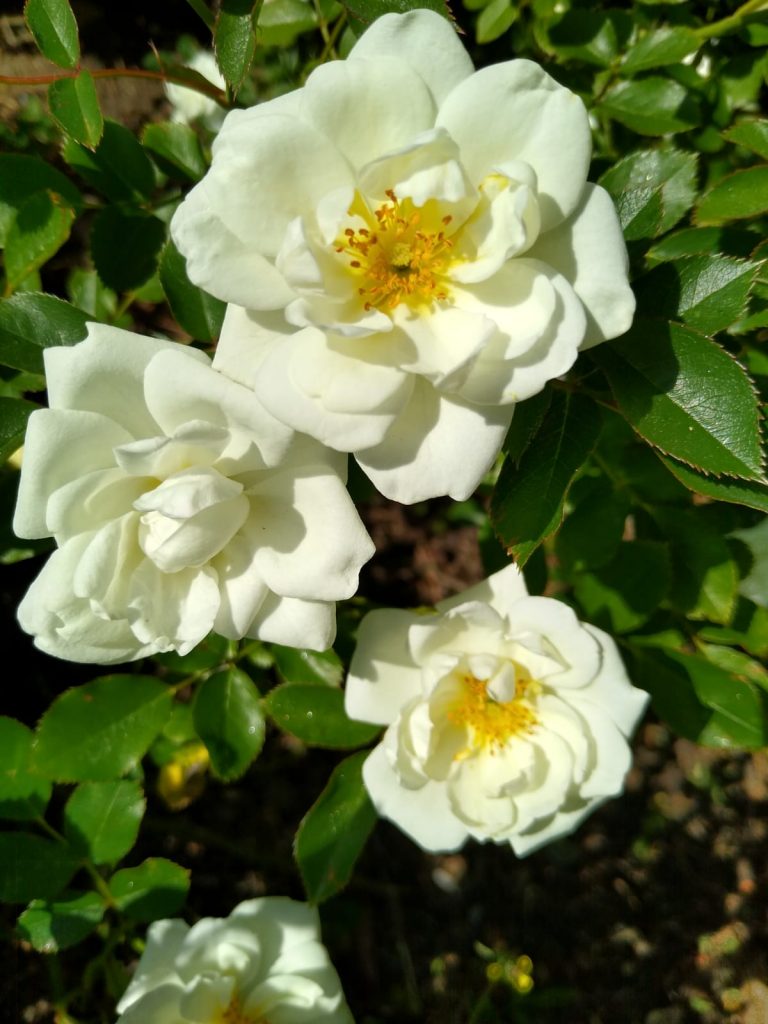
A blue rose signifies mystery and the red rose reflects true love. The black rose, which is in fact a very sombre and dark red colour, is a signal of death and a yellow rose signifies friendship. Pink roses signify gratitude, grace and joy. Rose petals are often used instead of shop-bought paper confetti to celebrate the wedding of a bride and groom and are thrown when the happy couple leave the church Rose confetti can be readily made at home by either collecting fresh rose petals or by laying petals on a sheet of cloth or paper in a warm room to dry out. In religion, the rose has been taken to symbolise death and resurrection. If a single red rose is placed alongside a white one it signifies the death and resurrection of Christ.
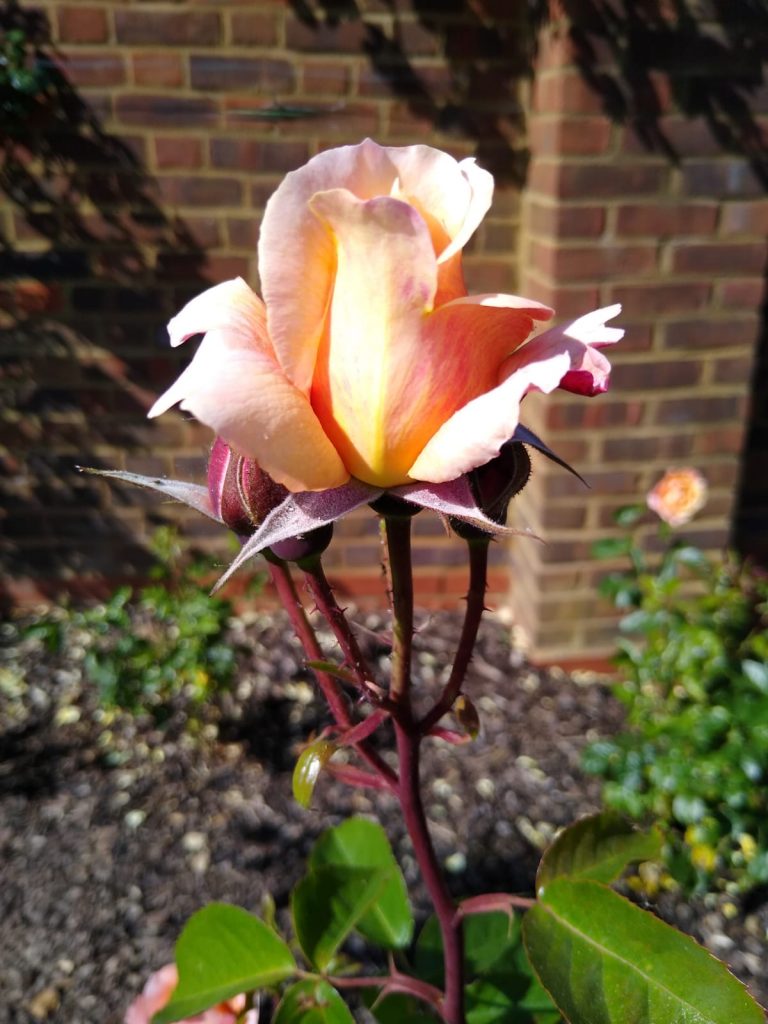
The rose is the national flower of England and is worn proudly by the respective English national teams in football, rugby and cricket. During the Wars of the Roses, which took place from 1455 to 1487, roses came into national prominence as they represented the two houses that competed to rule England. The House of Lancaster was represented by a red rose and the House of York by a white rose. The Lancastrians beat the Yorkists and Henry VII began the Tudor Dynasty in England. The Tudor Rose was born from those times and combines the two houses’ red and white roses in the newly formed Tudor or Union Rose. It was on 20 November 1986 that President Ronald Reagan declared that the rose should be adopted as the United States national floral emblem. This was whilst he was relaxing in the rose garden at the White House on that day. The United States of America formally adopted the rose as its national flower symbol in 1986 and it is the emblem of 4 of the states – Iowa, New York, North Dakota and Georgia. There are many quotes in literature and many poems that have been written about the beauty of these flowers and their symbolism. For example, in Shakespeare Juliet quotes “A rose by any other name would smell as sweet” to show that the love she shared with Romeo was real, despite the rivalry of their respective families – the Montague and Capulet houses. Roses have more than 4000 songs written about them. These include the well known La Vie en Rose, originally recorded by Edith Piaf; Lynn Anderson’s original recording of Rose Garden and Red Roses for a Blue Lady, recorded by Dean Martin. Rose has been a favourite girl’s name in English speaking countries to this day and the word for rose is often used as a girl’s name in other countries in their respective languages such as Roisin in Ireland, Rosa in Spain and Portugal, Rosalie in Denmark and France, Roos in the Netherlands and Rosana in Italy .
Culinary, commercial and medicinal uses
Rose petals are edible and can be used in a variety of salads, or they can be crystallised to decorate desserts. Crystallised rose petals taste exactly how a rose smells – fresh and fragrant. There are tiny scent glands contained on each rose petal which release their fabulous scents. In order to make crystallised rose petals at home, beat an egg white and fold in 8 ounces, or a cup, of caster sugar. Wash and dry the rose petals beforehand, then coat each rose petal, or the full rose flower, with this prepared egg white and sugar (meringue) solution. Place the rose petals, or whole rose flowers, on a sheet of parchment or greaseproof paper, then either keep them in a warm room for about 2 to 4 hours to allow the petals to dry out, or alternatively bake for a similar time with the oven door slightly ajar on a low heat of no more than 150 degrees Fahrenheit. Rose hips can be eaten and are full of vitamins including vitamins C, D, E and A. There are rose hip jams, teas, syrups and jellies. Rose hip syrup is rich in vitamin C and helps the immune system to fight diseases and is an old fashioned remedy for osteoarthritis and rheumatoid arthritis. It also makes a delicious alternative topping for ice cream desserts. The antioxidants in rose hips are flavonoids, which help the circulation of the blood and help to reduce high blood pressure. To make a batch of rose hip syrup at home, collect about 1000 grams of rose hips which equates to about 36 ounces, and top and tail the rose hips before halving each one. If the rose hips are large, remove the seeds at this stage. If they are small continue without removing the seeds. Place into a blender, or food processor and quickly pulse before placing in a pan with a litre, which is about three and a half pints of water. Bring to the boil and simmer for about 15 minutes. Strain through a muslin cloth or bag and press the boiled rose hips into the muslin to create a residual puree. Ensure that most of the liquid is drained out then return the puree from the muslin cloth or bag to the saucepan with a second litre of water. Boil it up again and simmer for another 15 minutes. Again sieve this mixture through a clean muslin bag and combine with the first litre of boiled rose hip liquid in a pan. If you want to be absolutely sure that all the tiny hairs from the inside of the rose hips have been removed, the combined liquid can be doubly strained through muslin at this point. Boil up this combined liquid until it reduces to about half its original volume. The more the liquid is reduced, the thicker and more viscous the syrup will be. Then add 1000 grams of sugar (about 36 ounces) and boil again for about 5 minutes. The syrup will be boiling hot for longer than plain water would be because of the sugar content, so please take care at this stage. When cool enough, transfer the syrup to the sterilised jars and store in a cool place until ready to use and enjoy. These ingredients will make about 1 litre (3 – 4 pints) of syrup. The quantities of ingredients can be varied in accordance with need. Rose hip oil can be extracted from the rose hip seeds and is rich in vitamin A. Rose hip oil is sometimes considered a good anti-aging treatment when gently rubbed into the skin. Rose oil, by contrast, is distilled from the rose petals. There are two types of rose oil – Rose Otto which is a pure essential oil distilled by the steaming method and Absolute Rose Oil which is chemically produced to create a very heady and pungent oil concentrate.. Rose oils are good for hydrating the skin and have been used to clear up skin conditions such as acne, eczema and rosacea, Rose oils are also good for helping to reduce scarring of skin tissue and are also believed to have good anti-aging effects. The countries that produce most of the world’s rose oils are Bulgaria and Turkey, although many other countries such as France, Morocco, Mexico, China and India are involved in smaller scale production. Bulgaria is considered to produce the best quality rose essential oil. It is referred to as ‘liquid gold’ in that country. It is an expensive commodity, firstly because of the number of rose petals needed to make tiny amounts of the product and secondly because of the high costs of production. Rosewater is an anti-inflammatory and contains antioxidants. It is used to flavour foodstuffs, such as Turkish Delight. It can also help hydrate skin and often provides a base for rose creams. Roses are used by many famous perfume houses across the world to make perfumes and a range of beauty products, Rosa Centifolia, alternatively known as the Provence or Cabbage Rose, found in the South of France, and the damask rose or Rose Damascene, found in Asia, are the two most popular roses used by perfume houses because of their intoxicating scents and variety of tones ranging from sensual, musky and woody to bright, fresh floral notes.It is hard to believe, but around three quarters of all women’s perfumes and around a fifth of all men’s contain rose extracts. It takes around 2000 roses to produce a gram of rose oil for the perfume industry and around 10000 roses to make the equivalent of 1 teaspoonful of rose oil. It is no wonder that in that concentrated form it is the favourite of many perfume houses – a minuscule amount provides a wealth of olfactory delights. The most expensive perfume in the world, Clive Christian’s No.1 Imperial Majesty, contains rose oil. Those accredited to be the most luxurious, expensive and opulent perfumes in the world contain rose oils. One of the most famous women’s perfumes, Chanel No. 5, has rose oil as one of its essential components. It was produced under the direction of Gabrielle ‘Coco’ Chanel, who used a Franco-Russian perfumer, Ernest Beaux, who was then based in Grasse in France, a centre for perfume and rose oil production, to create 10 individual perfume samples. No. 5 was chosen as typifying the scent that Coco was pursuing – for her, No. 5 was the ultimate scent of a woman. Chanel No. 5 was Coco Chanel’s first perfume, first launched in 1921. It was cleverly marketed in its distinctive bottle and was a break from the then traditional perfumes for women. It became an instant success, which has stood the test of time to this day.
10 miscellaneous and interesting rose facts
Fact 1 – The oldest known living rose bush is outside the wall of the cathedral at Hildesheim in Germany. This rose bush is believed to be over 1000 years old. This rose bush has been documented to have been planted and grown in that location since AD 815 around the time when the original cathedral was built. It is said that the prosperity of the city will remain whilst the rose bush continues to flourish. During the Allied invasion of Germany, the cathedral of Hildesheim was bombed, yet the rose bush, which was buried under rubble at the time, began to grow again from its strong roots and to thrive once more. It can still be seen to this day flowering outside the rebuilt Hildesheim Cathedral.
Fact 2 – The largest private rose garden is found at Cavriglia in Italy which has over 7000 varieties of rare and often unique roses in its grounds. It was started in 1967 by Professor Gianfranco Fineschi, who has created a living testament to roses for the many visitors who come from around the world to enjoy his garden. The garden is now dedicated to his wife and companion Carla and is named the Roseto Botanico Carla Fineschi in Italian.
Fact 3 – The rose is one of only three flowers to be mentioned in the bible. The other two flowers in the bible are lilies and the camphire (henna).
Fact 4 – The smallest rose flower is about 1 centimetre in diameter and its rosebud is roughly the size of a grain of rice. Dr Sudhir Khetawar cultivated this tiny rose in Madhya Pradesh in India. It is named the ‘Diamond Rose’.
Fact 5 – In 2002, the US space agency, NASA, launched a rose into space to test how the rose’s scent would be affected by gravity. ‘Overnight Scentsation’ was the chosen variety for this study, which also looked at how the scent of the rose could be improved in commercial applications.
Fact 6 – The essential oil distilled from a rose is in the top 10 of the most expensive essential oils in the world. It is in sixth place in the top 10 listing based on the cost of production at around $1000 or £820 per ounce.
Fact 7 – The most expensive rose in the world is the Juliet Rose, which was developed by English rose breeder, David Austin, in 2006. It is termed the most expensive rose in the world because it costs £3 million to develop over a 15-year period. It is a beautiful full bloomed, bowl-shaped, blousy rose with petals reflecting shades of soft peach and apricot. This rose is perfect for a luxury wedding bouquet.
Fact 8 – The tallest rose in the world is a climber named Cecile Brunner. It was recorded by Guinness World Records at 91 feet tall – that’s the height of about 8 stories of a block of flats! This rose belonged to Anne and Charles Grant of Los Angeles, California who invited Guinness World Records to take its measurements on 1 August 2004.
Fact 9 – The largest rose bush in the world is in Tombstone, Arizona and covers 9000 square feet of ground. It’s located not far from the site of the OK Corral. The OK. Corral is where the famous shootout happened between the Clanton- Maclaury gang and the Earps on 26 October1881. The shootout was to decide who would control Tombstone and Cochise County. The Tombstone rose is a White Lady Banksia rose, which is a tea rose bush with pretty white flowers which appear in March and April. In 1884, the story of this rose bush began when a young miner, Henry Gee, and his wife Mary arrived to work in the Tombstone mines from Scotland. In 1885, a box arrived from Scotland, which Mary’s family had sent with seeds and cuttings from the garden Mary missed so much. Mary gave one of the rose cuttings to her friend, Amelia Adamson, who ran the lodging house for the mining company. Remarkably this rose cutting from Scotland’s cooler climes flourished in the heat of the Arizona desert. The miners’ lodging house was renamed the Rose Tree Inn in 1936. Robert Ripley stayed there for a week in 1937 and included this rose in his ‘Believe it or Not’ column as the world’s largest rose bush. This rose was also both measured as the world’s largest rosebush and recorded nine decades later in the Guinness Book of World Records and its position has never since been challenged. The Rose Tree Inn closed in 1954 when it became a private dwelling house The new homeowners continued to allow public viewing of the well-loved enormous rosebush until the museum opened on the other side of their trellised, giant rosebush. Today this wonderful rosebush can be seen at the rear of the Rose Tree Museum in Tombstone.
Fact 10 – A blue rose was first created in 2009. This was bred in a genetic engineering programme, as rose petals did not naturally contain the correct pigment to create a blue flower. The first blue rose was named ‘Applause’ and was developed by a Japanese company that also makes whisky In Tokyo. The Applause rose’s distinctive blue colour was the result of a successful chemical synthesis of the blue pigment found in blue flowers such as the blue delphiniums. This pigment is called delphinidin.